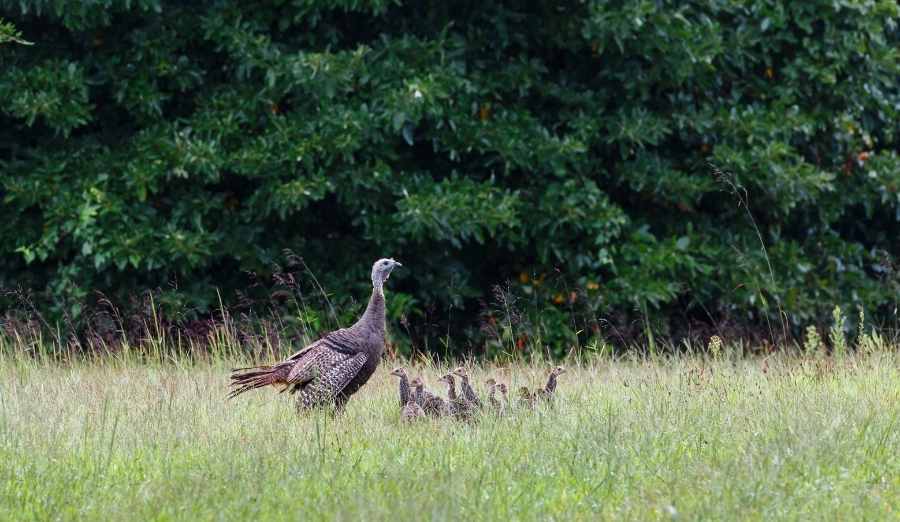Differentiating between Eastern Turkey and Osceola Turkey is critical to refining your hunting skills.
Each turkey species has unique characteristics, from vocal responses to behavior towards decoys.
Eastern turkeys are generally more receptive to raspy calls, whereas Osceola turkeys often prefer a more subdued approach.
For decoy strategies, Osceola gobblers tend to be more committed.
Grasping these distinctions is essential for enhancing your hunting strategies and increasing your field success.
Contents (Jump to Topic)
ToggleLet’s dive into the specifics of Eastern and Osceola turkeys.
Vocal Differences
Regarding vocalization, Eastern turkeys typically react favorably to raspy and soft calling techniques.
On the other hand, Osceola turkeys lean towards quieter, more subtle communication.
Less is often more with Osceola gobblers, suggesting a sparse and silent call approach.
The estimated number of Osceola turkeys in Florida is about 100,000.
Physical Distinctions
Eastern and Osceola turkeys, two subspecies of wild turkeys in North America, exhibit notable differences in size and appearance.
Weight
Eastern turkeys are generally larger than Osceola turkeys. Males of the Eastern subspecies typically weigh between 18 and 30 pounds, whereas Osceola and Rio Grande male turkeys usually weigh about 20 pounds.
Specifically, Eastern turkeys are the heaviest among turkey subspecies, regularly exceeding 25 pounds.
In contrast, Osceola turkeys, native to central and southern Florida, are smaller, with males maxing out at around 20 pounds.
Appearance
Beards: Eastern turkeys have longer beards than Osceola turkeys, which are known for their shorter beards.
Gobbles: Eastern turkeys are characterized by their louder gobbles, while Osceola turkeys have quieter gobbles.
Coloration: Osceola turkeys are much darker in color compared to Eastern turkeys. They also have distinctive white bands in their wings, which set them apart from other turkey subspecies.
Furthermore, Osceola turkeys have dark brown tail feather tips and wing bars, with their primary feathers consisting more of black than white.
Legs and Spurs: Osceola turkeys have longer legs and very long spurs, in contrast to Eastern turkeys
Response to Calling
The way Eastern and Osceola turkeys respond to calls differs markedly. Eastern turkeys generally respond better to softer, raspy calls.
Conversely, Osceola turkeys, favoring silence, can be trickier to call, especially in the dense, humid Floridian terrain where sounds can dissipate.
Using decoys like a Dave Smith jake and hen in Florida can effectively attract Osceola turkeys, especially on private lands with less hunting pressure.
In areas with higher pressure, consider adopting an ambush strategy instead.
Hunting Tactics
Different tactics are necessary for hunting Eastern versus Osceola turkeys.
The terrain’s dense foliage and humidity require a different use of decoys and calls in Florida.
A Dave Smith jake and hen set can work well in low-pressure areas. However, in high-pressure areas, an ambush approach might be more effective.
Bow hunting Osceolas offers an added challenge, and timing the implementation of these tactics is vital.
Decoy Strategies
Effective decoy use can significantly boost your hunting success with different turkey subspecies.
A Jake and Hen decoy setup can be compelling for Osceola gobblers, particularly on private lands.
An ambush strategy might yield better results on public lands with higher hunting pressure.
Navigating the dense foliage of Florida requires skill, and remember, Osceolas tend to commit to decoys more readily than other subspecies.
Roosting Behaviors
Roosting behaviors of Eastern and Osceola turkeys differ, influencing hunting strategies.
Eastern turkeys often roost in mature pine forests and may select trees over water. These turkeys are more common in northern Florida and adapt to their habitats.
Conversely, Osceola turkeys prefer roosting in cypress swamps and near palmetto fields, often in taller trees, typical of South Florida’s landscape.
Before you go…
For a bow hunter, recognizing the differences between Eastern and Osceola turkeys is crucial for successful hunting.
It’s about understanding their responses to calls, decoys, and tactics. Now, apply this knowledge in the field for a more rewarding hunting experience.
Happy hunting!
Sources:
https://www.bowhunting.com/blog/2018/02/26/eastern-turkey-vs-osceola-turkey-whats-difference/
https://johninthewild.com/eastern-and-osceola-turkeys-versus-western-turkeys-differences-in-calling-and-hunting-them-with-ryan-solomon-day-1-you-can-call-eastern-and-western-turkeys-with-ryan-solomon/
https://www.mossyoak.com/our-obsession/blogs/turkey/what-makes-an-osceola-turkey-an-osceola
https://projectupland.com/turkey-hunting/osceola-wild-turkey-meleagris-gallopavo-osceola/






